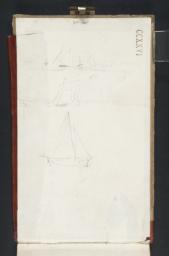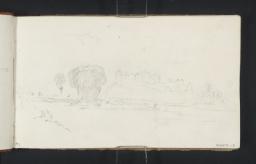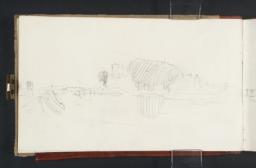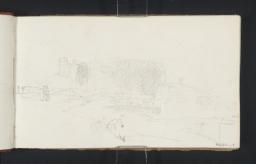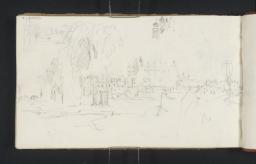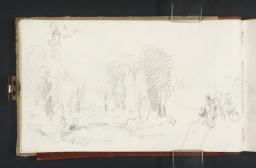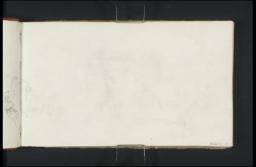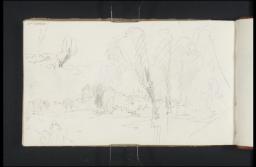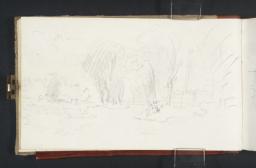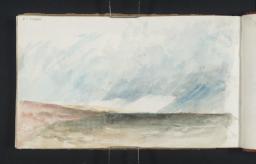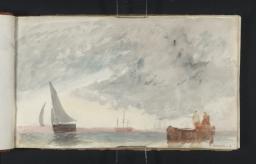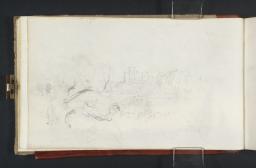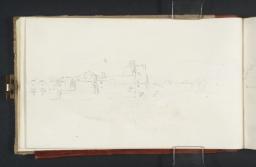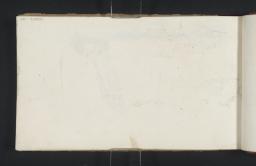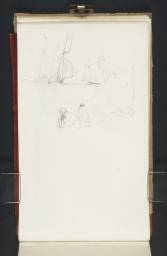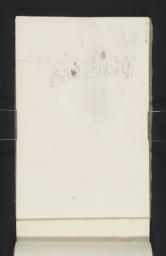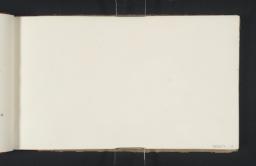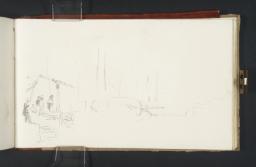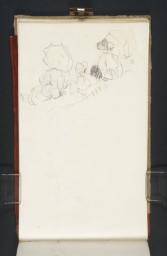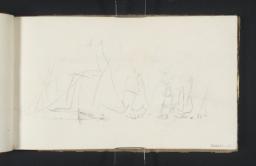Turner Bequest CCXXVI 1–81a
Sketchbook bound in boards, quarter-bound in grey paper over red-brown leather spine, with one brass clasp
84 leaves and paste-downs of white wove paper; page size 112 x 192 mm; watermark ‘R Barnard | 1820’
Made by Richard Barnard of Eyehorne Mill, Kent
Inscribed by Turner in ink ‘Windsor’ on the spine (D41014)
Numbered 341 as part of the Turner Schedule in 1854 and endorsed by the Executors of the Turner Bequest, Charles Turner, Charles Lock Eastlake and John Prescott Knight, inside back cover (D41018)
Blind-stamped with Turner Bequest monogram on back cover, towards bottom right
Stamped in black ‘CCXXVI’ on front cover, top right
84 leaves and paste-downs of white wove paper; page size 112 x 192 mm; watermark ‘R Barnard | 1820’
Made by Richard Barnard of Eyehorne Mill, Kent
Inscribed by Turner in ink ‘Windsor’ on the spine (D41014)
Numbered 341 as part of the Turner Schedule in 1854 and endorsed by the Executors of the Turner Bequest, Charles Turner, Charles Lock Eastlake and John Prescott Knight, inside back cover (D41018)
Blind-stamped with Turner Bequest monogram on back cover, towards bottom right
Stamped in black ‘CCXXVI’ on front cover, top right
Accepted by the nation as part of the Turner Bequest 1856
Exhibition history
References
This sketchbook largely comprises topographical coastal views on the Isle of Wight, particularly around Cowes and East Cowes at the mouth of the River Medina, and a large number of studies of shipping there and in the adjacent Solent, including yachts involved with the events of the 1827 Cowes Regatta (its second year). Turner was a guest of the architect John Nash at East Cowes Castle, as discussed in the overall Introduction to this tour.1 The slightly long-winded title, ‘Windsor and Cowes, Isle of Wight’, was presumably formulated by Finberg reflect its contents more clearly,2 Turner’s labelling being limited to a terse ‘Windsor’ on the spine (D41018).
Interspersed in the first few pages are views along the River Thames, showing Windsor Castle and nearby Eton College (see under folios 2 recto and 10 recto respectively; D20598, D20610), both of which were already familiar to Turner. Informing two watercolours engraved in 1831 for Turner’s Picturesque Views in England and Wales, the drawings here probably preceded the Isle of Wight material, perhaps earlier in the same year, and they have been dated here to c.1827. Compare the rural Thames material scattered through the Isle of Wight sketchbook (Tate; Turner Bequest CCXXVII), also associated with this tour, including Hampton Court studies used for another England and Wales subject. The only other clearly identified view away from the Isle of Wight and the Solent is of the waterfront at Southampton, across the Solent (folio 10 verso; D20611), which he may have passed through on his way to or from the island; see also the harbour views at nearby Portsmouth in the Isle of Wight book, and others of Southampton in the Cowes Regatta sketchbook (Tate; Turner Bequest CCVII).
The present book contains many views including Nash’s East Cowes Castle (see under 1 verso; D20597), nearby Norris Castle (see under 40 recto; D20658; Turner Bequest CCXXVI 38), and Cowes Castle (see under 72 verso; D20710; Turner Bequest CCXXVI 70a), all overlooking the Medina and the Solent. The last of the three seems to have been a favourite shoreline vantage point for spectators (see under 13 recto; D20615; CCXXVI 12), as shown in the one of the two paintings commissioned by Nash, East Cowes Castle, the Seat of J. Nash, Esq.; the Regatta Starting for their Moorings (Victoria and Albert Museum, London),3 exhibited at the Royal Academy in 1828 along with East Cowes Castle, the Seat of J. Nash, Esq.; the Regatta Beating to Windward (Indianapolis Museum of Art).4
Turner’s research includes a list of racing results for Cowes events between 31 July and 2 August 1827, with the names, owners, weights and colours of the yachts, on folio 84 verso (D20730; Turner Bequest CCXXVI 80a). None of the pencil studies here informed the finished regatta paintings very directly, but they served as grist to Turner’s mill as he developed the subject in the various oil sketches noted in the overall Introduction, and in the Cowes Regatta sketchbook, which contains numerous drawings which can be related more closely to the paintings. Three seascapes in watercolour alone in the present book (folios 8 recto, 9 recto, 11 verso; D20607, D20608, D41016) may show Turner developing pictorial ideas for further compositions.
Finberg recorded John Ruskin’s endorsement on a wrapper: ‘341. Eton, Windsor, and Marines. A book of considerable value.’5
Technical notes
How to cite
Matthew Imms, ‘Windsor and Cowes, Isle of Wight sketchbook 1827’, sketchbook, November 2015, in David Blayney Brown (ed.), J.M.W. Turner: Sketchbooks, Drawings and Watercolours, Tate Research Publication, November 2016, https://www

